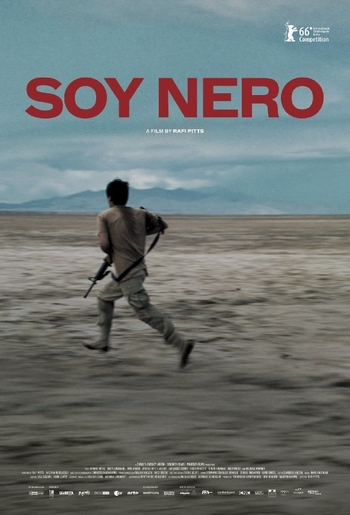Berlinale 2016 Review: First, SOY NERO Dazzles, Then It Disappoints

Not a sequence, nor an edit. Can a solitary, unbroken shot make or break a film? Can it upend one's total reception of a work? Because there is a shot at the very beginning of Soy Nero that is so striking, so magnificently realized in respects both visual and thematic that it serves as a kind of opening-scene plot twist. You begin Soy Nero thinking you're watching something spectacular, when turns out to have been disappointingly half-baked all along.
Some context first. The fellow in this glorious shot is Nero, our lead. A young man in his late teens, Nero is a DREAMer. That is, he belongs to a subset of young Latinos -- named for an as of yet not passed Federal bill aimed at helping undocumented children, the DREAM act -- brought into the United States as children and raised as Americans, making the threat of deportation all the more devastating. Our young lad has unfortunately lived that nightmare several times over, and the film opens on the final moments of what must be his second or third doomed attempts to reenter the country.
Documented or not, you can't keep a good American down, and soon enough the kid is right back at it. And that brings us back to The Shot.
Choosing New Year's Eve for his attempt, Nero waits until the clock strikes midnight before bolting across a scarcely manned crossing, while the armed guards obliviously celebrate in the background and fireworks ferociously paint the sky overhead. By any standard, the deep-focus shot, framed by director Rafi Pitts and lit by cinematographer Christos Karamanis, is a technical knockout. I say from experience that it had an instant, narcotic effect on the 1600 rabid cinephiles at this morning's press screening. All of which made the collective deflation all the more appreciable as the film's real story kicked into gear.
Nero's problem is not entering the US, but staying put. So he opts to become a 'green-card soldier' as the army offers a green card for service arrangement, although it seems the only ones actually gaining citizenship are those killed in action. Divided into two parts, the film's top half follows Nero on his first couple days back stateside as he makes his way to enlistment, while the second finds him on duty in a Middle East war zone.
That first half -- which sees Nero picked up by an ornery veteran who turns out to be a paranoid nut, and potentially something far, far worse, nearly arrested by two skeptical cops, and finally reunited with his older brother, living in conditions of wealth and luxury that don't quite square with his rang on the totem pole -- plays out like a paranoid thriller where danger lurks around every corner and no one is quite as they seem. Well, not to Nero anyway. The viewers are usually two-steps ahead in every instance, waiting for the film to speed up, but that's ok. We're still buzzed on the electricity of the beginning, we can handle obvious.

When we get to the Middle East, however, things goes off the rails. Nero, now going by the name Jesus, is flanked by fellow soldiers with the equally on the nose names of Compton and Bronx -- can you guess where they come from? -- and they go round for round, with Pitts treating the unnamed warzone as a symbolic field where one by one he's going to settle America's scores.
The conversations -- do African-Americans or undocumented immigrants have it worse? West Coast or East Coast rap? -- are earnest in intent and excruciating in execution. The absolute nadir comes when Pitts drops in a Muslim US soldier to argue that you can practice your faith and still serve your country, and then promptly does away with him. What's this polemic device-masquerading-as-a-character named? Mohammed, of course.
Look, I have no objection to the film's liberal slant. Fact is, it's pretty much in sync with my own. But that doesn't mean I want to a film to flatter my politics at the expense of my intelligence. And the half cooked, dorm room conversations are so far removed from any real life bearing and so unrepresentative of American experience that I wonder if the director and writer have spent any significant time in the culture they seek to represent. To add insult to injury, the film seems to recognize that too, and promptly segues into a beat-for-beat remake of The Hurt Locker for the next stretch. This too is indicative of a kind of laziness.
Narrative laziness, that is, because the technical aspects remain spot on throughout. Pitts loses the audience while keeping the film tightly edited and sharply composed. When I say beat-for-beat remake I mean it. He keeps the tension, and he can work suspense. But like, why? To what end? The film's message is so superficially thought through that it doesn't say anything at all, leaving you mildly dazzled but generally disappointed. Great but lazy filmmaking is still lazy filmmaking. It all just makes you nostalgic for a less complicated time. A time when you could marvel at Pitts' compositions without any reservation, like, say, towards the beginning of the film...
Oh man, that really was a great shot.
Soy Nero
Director(s)
- Rafi Pitts
Writer(s)
- Rafi Pitts (original story)
- Rafi Pitts (screenplay)
- Razvan Radulescu (screenplay)
Cast
- Rory Cochrane
- Khleo Thomas
- Michael Harney
- Aml Ameen

Do you feel this content is inappropriate or infringes upon your rights? Click here to report it, or see our DMCA policy.






